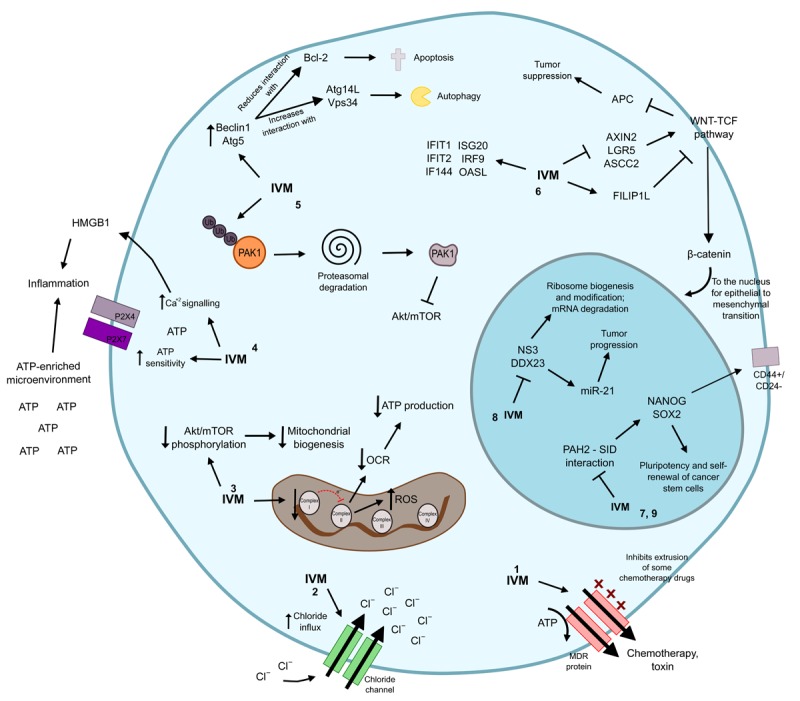Figure 2.

Antitumor mechanisms of ivermectin. 1. Ivermectin inhibits the P-glycoprotein pump, that induces a multidrug phenotype in the cancer cell. 2. Ivermectin acts as an ionophore and up-regulates chloride channels to generate apoptosis and osmotic cell death. 3. By decreasing the function of the mitochondrial complex I, ivermectin limits the electronic movement in the oxidative phosphorylation pathway that stimulates oxygen consumption rate to generate ATP for the cell. Concomitantly there is a reduction in the phosphorylation levels of Akt, impacting in the mitochondrial biogenesis process. Furthermore, alterations in the mitochondrial machinery are related with increased levels of reactive oxygen species that damage DNA. 4. Ivermectin induces ICD through the stimulation of an ATP- and HMGB1-enriched microenvironment, which promotes inflammation. This drug also increases ATP sensitivity and calcium signals in P2X membranal receptors, particularly P2X4 and P2X7, to induce ATP-dependent immune responses. 5. Ivermectin promotes the poly-ubiquitination of the kinase PAK1, which directs it to degradation in the proteasome. Defective PAK1, in turn, inhibits the Akt/mTOR pathway. At the same time, ivermectin stimulates the expression of Beclin1 and Atg5, both related with induction of autophagy and reduces the function of the negative regulator of apoptosis Bcl-2. Together, this generates autophagy and apoptosis. 6. Ivermectin represses AXIN2, LGR5 and ASCL2, all of them positive regulators of WNT-TCF while promotes the repressor of the WNT signaling FILIP1L. Concomitantly, ivermectin promotes the expression of several IFN-related genes, such as IFIT1, IFIT2, IF144, ISG20, IRF9 and OASL. 7. Ivermectin modifies the epigenetic signature and the self-renewal activity in the malignant cell due to its ability to mimic the SIN3-interaction that binds to the PAH2 motif of the cancer-associated deregulators SIN3A and SIN3B. SIN3A naturally induces NANOG and SOX2, which are stimulants of stem cell pluripotency. 8. Ivermectin limits the function of the RNA helicases NS3 and DDX23, both of which are related with ribosome biogenesis and post-transcriptional modifications, as well as with mRNA degradation. DDX23 acts as a promoter of miR-21, which is a well-recognized stimulator of tumor progression. 9. Ivermectin inhibitis preferentially the CSC population and up-regulates pluripotency and self-renewal genes NANOG, SOX2 and OCT4. IVM: ivermectin; ATP: adenosine triphosphate; OCR: oxygen consumption rate; ROS: reactive oxygen species.
